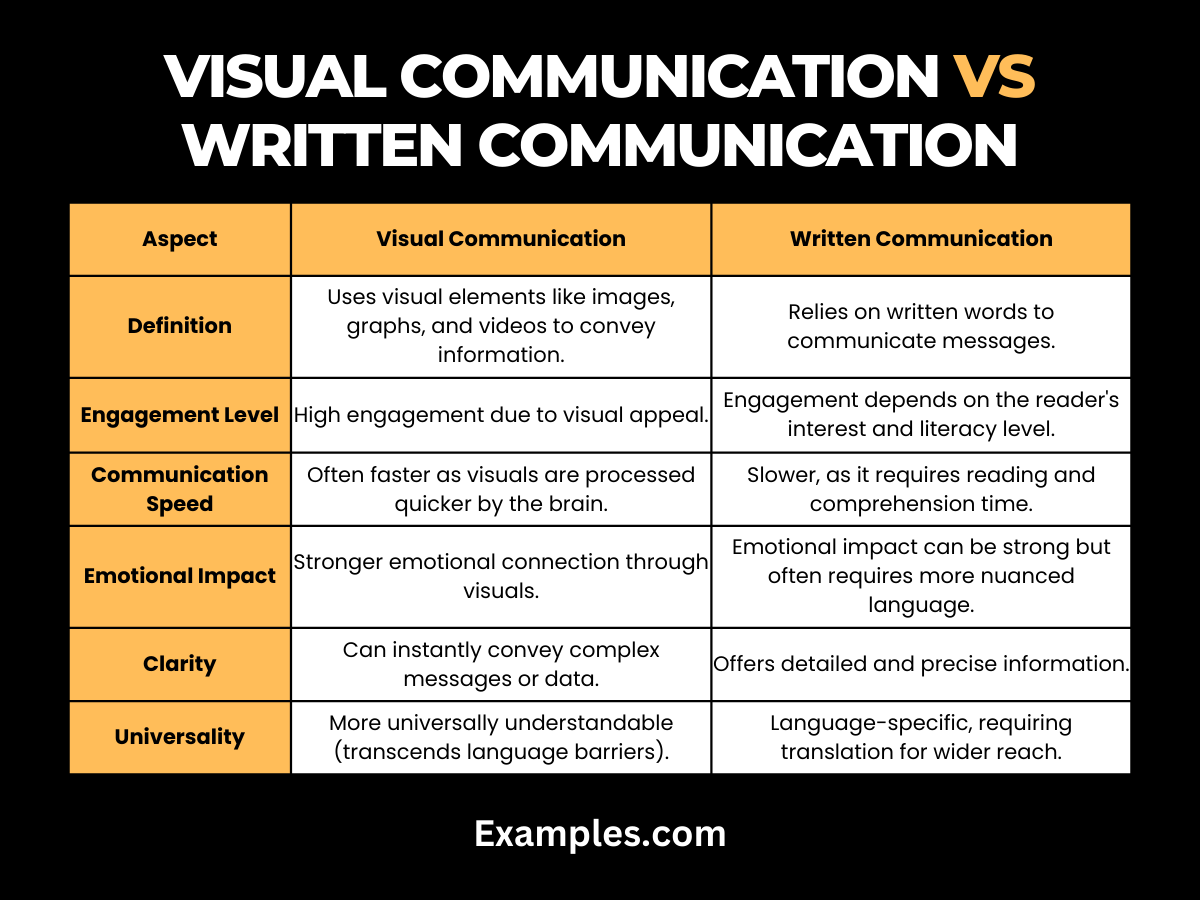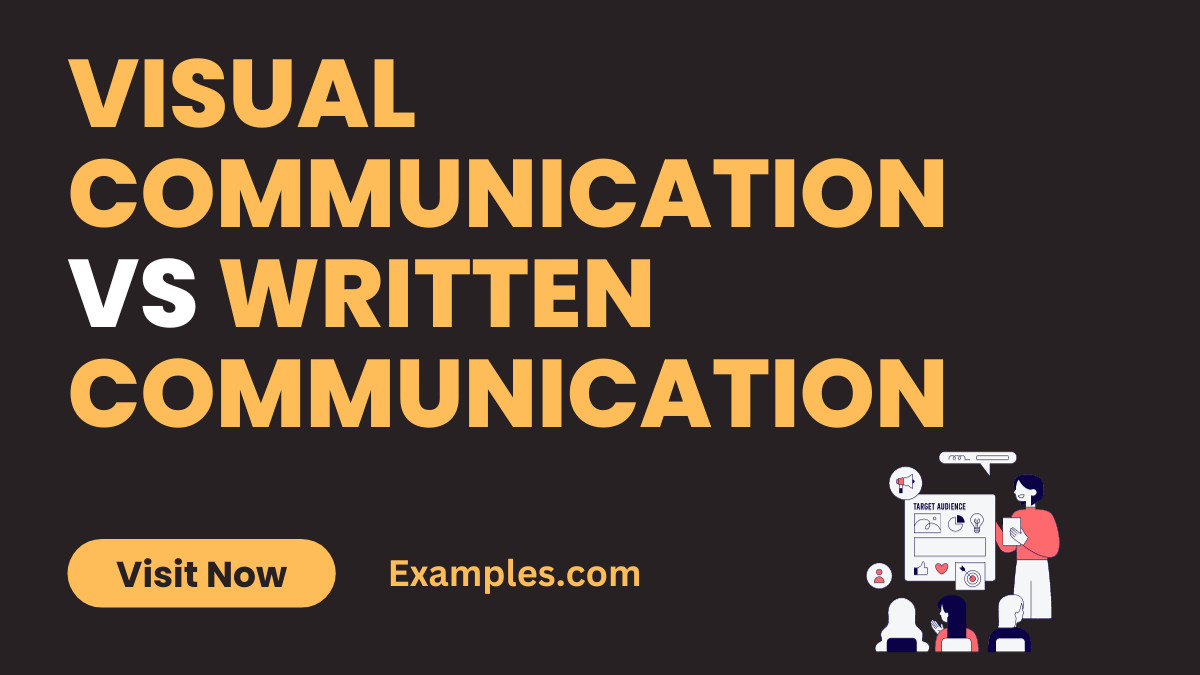Visual Communication vs Written Communication
In this comprehensive guide, we explore the dynamic interplay between visual communication and written communication. Delving into various communication examples, we examine how each form excels in different contexts. From the Advantages of Visual Communication in conveying complex concepts quickly and memorably to the Effectiveness of Written Communication in providing detailed and nuanced information, this guide offers a balanced view. We’ll also cover strategies, tools, and practical examples illustrating how both forms can be effectively utilized in diverse communication scenarios.
Download Visual Communication Examples in PDF
Download Written Communication Examples in PDF
Difference between Visual Communication and Written Communication

This table highlights the key differences between visual communication and written communication, each having distinct advantages and applications. Visual communication excels in quickly delivering messages with broad appeal, while written communication offers depth and detail. The choice between the two depends on the context, audience, and message complexity.
| Aspect | Visual Communication | Written Communication |
|---|---|---|
| Definition | Uses visual elements like images, graphs, and videos to convey information. | Relies on written words to communicate messages. |
| Engagement Level | High engagement due to visual appeal. | Engagement depends on the reader’s interest and literacy level. |
| Communication Speed | Often faster as visuals are processed quicker by the brain. | Slower, as it requires reading and comprehension time. |
| Emotional Impact | Stronger emotional connection through visuals. | Emotional impact can be strong but often requires more nuanced language. |
| Clarity | Can instantly convey complex messages or data. | Offers detailed and precise information. |
| Universality | More universally understandable (transcends language barriers). | Language-specific, requiring translation for wider reach. |
| Memory Retention | Higher retention due to visual stimulation. | Depends on the reader’s memory and understanding. |
| Content Type | More suited for quick data presentation and storytelling. | Ideal for detailed explanations and narratives. |
| Technology Reliance | Heavily reliant on design software and tools. | Relies on basic writing tools and word processing software. |
| Skill Set Required | Design skills, creativity, understanding of visual aesthetics. | Strong writing skills, grammar, and language proficiency. |
10 Visual Communication Examples
Visual communication, an integral part of our daily interactions, utilizes imagery, color, and design to convey messages in an impactful and efficient manner. Here are 10 distinct examples of visual communication, each demonstrating how visual elements can enhance understanding and engagement:
- Infographics: Presents complex data in a visually digestible format, making it easier for the audience to understand and remember information.
- Logos: Represents a company’s brand identity, using visual design to create a memorable brand image.
- Signage: Provides directions, warnings, or information in public spaces, using symbols and texts that are quickly recognizable.
- Website Design: Combines aesthetics with user experience, using visual elements to guide and inform the user.
- Social Media Graphics: Captures attention on social platforms, using compelling imagery to engage viewers and convey messages.
- Animations: Tells stories or explains concepts in a dynamic way, often used in educational and marketing contexts.
- Video Games: Uses visual storytelling and interactive design to create immersive experiences.
- Product Packaging: Communicates brand values and product information visually, influencing consumer decisions.
- Advertisements: Uses visual strategies to promote products or services, aiming to attract and persuade potential customers.
- User Interface (UI) Design: Focuses on the visual aspects of software interfaces, ensuring user-friendly and aesthetically pleasing experiences.
10 Written Communication Examples
Written communication, a fundamental aspect of conveying information, relies on the written word to express ideas, convey messages, and share knowledge. Its effectiveness lies in clarity, precision, and the ability to be revisited. Here are 10 distinct examples of written communication, each serving unique purposes:
- Emails: The most common form of business communication, essential for quick, direct conversation.
- Reports: Detailed documents, often used in business and academics to present research, findings, or progress.
- News Articles: Journalism and news media use written articles to inform the public about events and issues.
- Academic Papers: Research and scholarly articles used in education to present findings and discussions.
- Business Plans: Detailed documents outlining a business’s strategy, goals, and operations.
- Letters: Personal or formal, letters are used for direct communication to a specific recipient.
- Social Media Posts: Written content on platforms like Twitter or Facebook, used for both personal expression and marketing.
- Legal Documents: Contracts, agreements, and legal filings, crucial for legal clarity and record-keeping.
- Instruction Manuals: Guides and manuals provide step-by-step instructions and information about products or services.
- Memoirs and Biographies: Personal life stories or histories of individuals, written to share experiences and lessons.
Comparison between Visual Communication and Written Communication
The comparison between visual and written communication is a fascinating study of how different modes convey information and evoke responses.
Visual Communication: A Snapshot of Efficacy
Visual communication uses imagery, colors, symbols, and designs to convey messages. It’s known for its immediacy and ability to transcend language barriers. Visual Communication Examples include infographics, logos, and UI/UX designs in apps, which demonstrate the importance of visual communication in today’s digital age. The Characteristics of visual communication involve engaging the viewer quickly and creating a lasting impression. In areas like Visual communication in photography and Visual communication in healthcare, the ability to convey complex information swiftly and effectively is crucial. For those interested in this field, exploring visual communication jobs, careers, salaries reveals a wealth of opportunities.
Written Communication: The Detail in Depth
In contrast, written communication uses words to express ideas, making it essential for detailed and nuanced expression. From emails to reports, it’s a staple in formal and academic settings. The Effectiveness of Written Communication lies in its precision and clarity, providing detailed explanations where visuals may not suffice. However, mastering Textual Communication Skills requires understanding the nuances of language and the audience’s needs. It’s particularly important in Visual communication in the workplace, where combining written and visual elements leads to effective overall communication.
Blending the Two for Maximum Impact
In practice, the best communication strategies often combine visual and written elements. For instance, a well-designed infographic (visual) accompanied by explanatory text (written) can enhance understanding and retention. How to use visual communication effectively often involves complementing it with written explanations, especially in complex fields like science or technology. Likewise, how visual communication works best is when it’s supported by text to give context and depth to the visual message.
Relationship between Visual Communication and Written Communication
The relationship between visual communication and written communication is a complex and multifaceted one, each playing a unique role in how we convey and interpret information. This relationship is vital across various fields, including Visual communication in the workplace, Visual communication in photography, and Visual communication in healthcare.
The Complementary Nature of Visual and Written Communication
Visual and written communication are often seen as distinct, yet they complement each other effectively. For instance, Visual Communication Examples in advertising often combine with persuasive written content to enhance the overall impact. Similarly, Types of Visual Communication, like infographics, can supplement written reports, making complex data more digestible and engaging.
Integrating Visual and Written Elements
The integration of visual and written communication can amplify the effectiveness of a message. In educational settings, Visual communication in healthcare utilizes both forms to convey crucial information to patients and medical professionals. This approach combines the Characteristics of visual communication—such as immediacy and engagement—with the detailed and specific nature of written communication.
The Role of Technology in Communication Methods
Advancements in technology have also blurred the lines between visual and written communication. Digital platforms often require a hybrid approach, utilizing both visual communication skills and textual communication skills. In visual communication jobs, careers, salaries, professionals are expected to be adept in both areas to cater to the evolving needs of the digital age.
Choosing the Right Communication Method
Understanding How to use visual communication and when to opt for written communication is key in various contexts. Visual communication in the workplace, for example, might require a different approach compared to Visual communication in photography. The choice depends on factors like audience, purpose, and the nature of the information being conveyed.
In conclusion, understanding the strengths and limitations of both visual and written mediums is crucial. Visual communication, with its instant appeal and universal understanding, breaks barriers that words sometimes cannot. It transcends language differences and offers an immediacy that written text often lacks. On the other hand, written communication provides depth, detail, and a personal touch that visual elements might miss. As outlined in the National Center for Biotechnology Information’s study “The Importance of Effective Communication”, the integration of both visual and written communication can enhance understanding and retention of information, particularly in complex fields like healthcare and education.
However, the effectiveness of communication, whether visual or written, hinges on the skill and understanding of the communicator. In today’s competitive business environment, mastering both forms of communication is not just an asset but a necessity. Courses like those offered at Johns Hopkins University, detailed in their “Business Communication” program, emphasize the importance of developing skills in both visual and written communication. This holistic approach ensures that professionals are equipped to convey their messages effectively, regardless of the medium. In conclusion, while visual and written communications have their unique advantages, the most impactful communicators are those who adeptly combine the strengths of both to convey their messages effectively and memorably.



